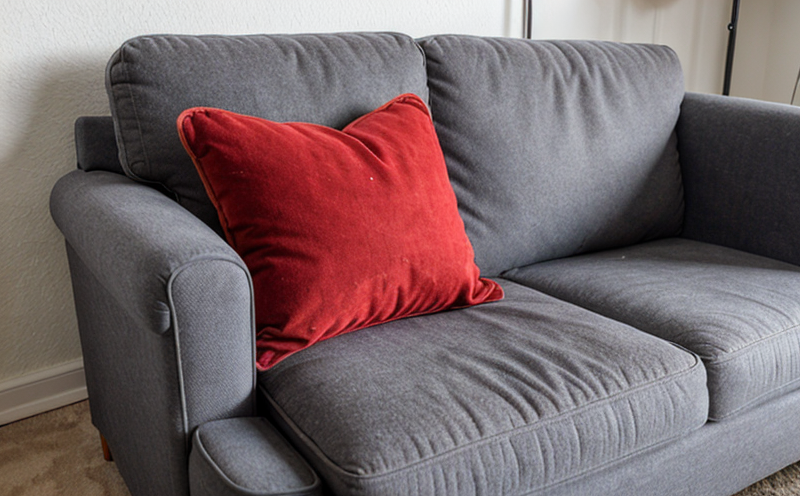ISO 3386 Determination of Stress-Strain Characteristics of Cushion Foams Testing
The ISO 3386 test is a critical procedure used to determine the stress-strain characteristics of cushion foams, which are essential components in furniture products. This test helps ensure that foam materials meet specific performance and safety standards. Understanding this test requires familiarity with the mechanical properties of cushion foams, their importance in furniture design, and how they contribute to user comfort.
The stress-strain behavior of cushion foams is a fundamental aspect of understanding how these materials will perform under different loading conditions. The test involves subjecting the foam samples to a controlled compression load, measuring the resulting strain at various points until it reaches failure or the specified maximum deflection. This information is crucial for furniture manufacturers as it allows them to optimize material selection and design for both comfort and durability.
Key parameters that influence the outcome of this test include the type of foam (open-cell vs closed-cell), density, and the specific loading conditions used during testing. These factors play a significant role in determining the ultimate load capacity and resilience of the cushion foam. Manufacturers can use the data obtained from this test to improve product design by selecting foams that provide optimal comfort while also meeting regulatory requirements.
Another important consideration is the role of sample preparation, which includes ensuring uniform thickness and consistent cutting of the specimens. Proper sample preparation ensures accurate and reproducible results, allowing for meaningful comparisons between different materials or batches within a single material type.
The ISO 3386 test aligns with broader quality control practices in the furniture industry by providing quantitative data on foam performance that can be used to verify compliance with relevant standards. This is particularly important given the increasing emphasis on sustainability and safety, especially regarding chemical emissions from materials like cushion foams.
- Uniformity of sample preparation
- Controlled loading conditions
- Reproducibility of results
- Compliance with international standards
- Data for design optimization
- Verification of material quality
In summary, the ISO 3386 test is a vital tool in the furniture industry for evaluating cushion foam performance. It provides valuable insights into stress-strain characteristics that are essential for ensuring product quality and safety.
Industry Applications
The ISO 3386 test finds extensive application across various sectors within the furniture industry. Its primary use is in the development and quality assurance of cushion foams, which are integral components of seating products such as chairs, sofas, and armchairs.
For manufacturers, this test helps ensure that foam materials meet specific performance requirements set by standards like ISO 3386. By providing precise data on stress-strain behavior, the test enables furniture makers to optimize their product designs for better comfort and durability. This is particularly important in competitive markets where consumer expectations are high and regulatory compliance is essential.
Additionally, the results from this test can be used during material selection processes. Furniture companies often use the data obtained through ISO 3386 testing to choose foams that not only meet their comfort needs but also comply with environmental regulations related to chemical emissions. This dual consideration enhances both product performance and sustainability efforts.
The test is equally beneficial for compliance officers who need objective evidence of adherence to international standards such as ISO 3386. Such documentation helps in meeting regulatory requirements, which are crucial for maintaining market access and ensuring legal compliance across regions.
In summary, the ISO 3386 test plays a pivotal role in several aspects of the furniture industry, from R&D to production and compliance.
Why Choose This Test
The ISO 3386 Determination of Stress-Strain Characteristics of Cushion Foams Testing offers several advantages that make it a preferred choice for furniture manufacturers:
- Precision in Material Selection: The test provides precise data on how foam materials behave under stress, enabling companies to select the most appropriate foams based on their intended applications.
- Enhanced Product Quality: By ensuring that cushion foams meet specific performance criteria, this test contributes to higher quality products, enhancing customer satisfaction and loyalty.
- Safety Assurance: Compliance with international standards like ISO 3386 helps manufacturers ensure the safety of their products, reducing the risk of accidents or injuries associated with improper foam materials.
- Competitive Advantage: Offering superior products backed by rigorous testing can give furniture companies a competitive edge in the market.
- Sustainability Focus: The test supports sustainable manufacturing practices by helping select foams that not only perform well but also meet environmental standards.
In conclusion, choosing the ISO 3386 Determination of Stress-Strain Characteristics of Cushion Foams Testing ensures that furniture manufacturers can produce high-quality products while adhering to international standards and promoting sustainability.
Use Cases and Application Examples
The ISO 3386 test finds application in various use cases within the furniture industry, each highlighting its importance for different aspects of product development and quality assurance.
Development of New Cushion Foams: Manufacturers often conduct ISO 3386 tests during the early stages of new cushion foam development. This helps them understand the basic properties of newly developed foams before proceeding to more complex testing or full-scale manufacturing.
Quality Assurance: Regular ISO 3386 tests are performed in quality assurance departments to ensure that all batches of cushion foams meet the required standards. These tests help identify any inconsistencies early, allowing for timely adjustments.
Compliance with Standards: Furniture manufacturers frequently use this test as part of their compliance efforts to demonstrate adherence to international standards such as ISO 3386. This is crucial for maintaining market access and ensuring legal compliance in different regions.
Sustainability Initiatives: The data obtained from ISO 3386 tests can inform sustainability initiatives by guiding the selection of foams that perform well while also meeting environmental regulations.
In summary, the ISO 3386 test is a versatile tool with wide-ranging applications in the furniture industry. Whether for developing new products or ensuring product quality and compliance, this test plays a crucial role.





